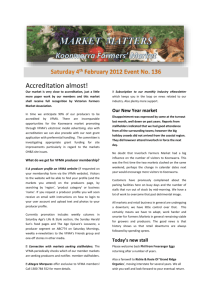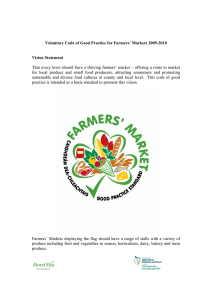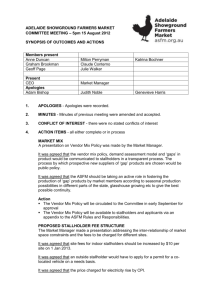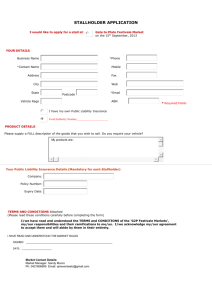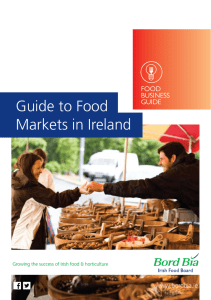Voluntary Good Practice Standard for Farmers’ Markets 2012-2013 Vision Statement
advertisement
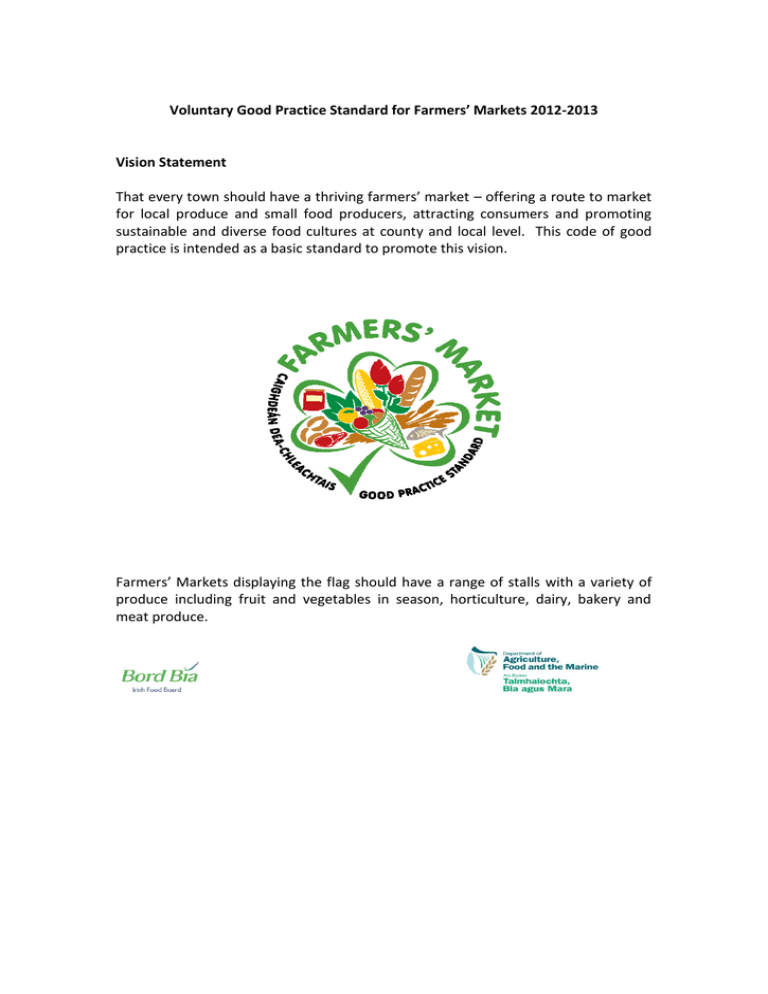
Voluntary Good Practice Standard for Farmers’ Markets 2012-2013 Vision Statement That every town should have a thriving farmers’ market – offering a route to market for local produce and small food producers, attracting consumers and promoting sustainable and diverse food cultures at county and local level. This code of good practice is intended as a basic standard to promote this vision. Farmers’ Markets displaying the flag should have a range of stalls with a variety of produce including fruit and vegetables in season, horticulture, dairy, bakery and meat produce. How the Voluntary Good Practice Standard operates: The Good Practice Standard is voluntary and all farmers’ markets operating in the State are eligible to apply. A non-refundable application fee of €50 per market applies. The Good Practice Standard is intended only as the minimum eligibility criteria. Market management may apply stricter criteria. Following successful application, a certificate and banner will be awarded to markets demonstrating ongoing compliance with the criteria listed at page 3 of this booklet. The banner must be displayed in a public place at the market location. Applications will be considered by an award committee, whose decision will be final. Unsuccessful applicants may re-apply as soon as they meet the full criteria. Adherence to the standard may be checked without prior notification. 2 Voluntary Good Practice Standard for Farmers’ Markets The Market must be managed and overseen by a committee, or in the case of local authority-run or privately-run markets, a manager, who will have overall responsibility for ensuring that the criteria for eligibility of the Good Practice Standard are complied with on an ongoing basis. Each market shall have a written policy/charter on the operation of the market. This policy must provide for: 1. A substantial proportion, ideally at least 50%, of the food and horticulture sold at the market should be sourced from local/artisan producers from the market county or adjoining counties. The market should endeavour to offer a variety of produce in season. 2. Compliance with legislation/regulation relating to food safety* including stallholder registration with the local EHO (Environmental Health Officer), labelling, waste disposal, insurance etc. The committee or manager should provide a course in essential food safety for stallholders or should otherwise direct stallholders to suitable courses. 3. The appointment of a market manager (or a nominated stallholder) to be present on the market day in order to oversee efficient set-up and breakdown, to ensure waste is removed and site is left in a reasonable condition and to be the point of contact with members of the public on the day. 4. (a) A written selection system for allocation of stalls. (b) Written guidelines for dealing with (all) disputes in the market. 5. A transparent system of fees for all stallholders. 6. Clear pricing of produce and the labelling of the place/county of origin to be displayed by all stallholders for all products. Organic produce must be verifiable at the point of sale. 7. A communal site/stall (when a demand exists) for the sale of local garden/allotment produce and seasonal foods. 3 8. Markets should be running for at least three months prior to application and in the case of monthly markets, at least four months. A Market should take place in a regular fashion - weekly, fortnightly or monthly, for at least 5 months of the year. There should be at least five stalls supplying a range of food and horticulture. * FSAI Guidance Note 16 relating to food stalls: http://www.fsai.ie/assets/0/86/204/38b489aa-c7c5-4526-b035f136860593f4.pdf 4 Voluntary Good Practice Standard Farmers’ Markets 2012-2013 Helpful hints For Market Organisers Diversity of products and producers Customers are attracted to a farmers’ market for a diversity of fresh, high quality, locally grown products. They want the widest possible selection of products and diversity within those product lines. They also want to have freedom of choice between producers of the products available. The more choices the market offers its consumers, the more attractive and exciting the market becomes for them. Quality and freshness The level of quality and freshness of goods for sale is paramount. Offering products of a high quality will encourage consumers to visit the market on a regular basis. One bad experience may mean a customer never returns again and poor word of mouth can have even more severe implications. Consistency It will take some months before your name/product becomes established and it is critical that you stick with your market for at least six months. Regular attendance, even in bad weather, is vital so that you do not disappoint your customers. Any break in a pattern could lose you business. Regular customers expect to see the same produce at each market. You should also ensure that the same produce, apart from seasonal produce, is consistently available at each market. Promotion For a market to be successful an effort must be made to inform customers and potential vendors that a market is or will be in operation. Therefore, promotion of the market is vital, i.e. interviews on local radio or adverts in newspapers, flyers etc. If people get a good impression of the market on their first visit they will in turn become regular customers. 5 For Stallholders Product display It is important to ensure that your stall looks attractive at all times, is properly merchandised and is visually appealing. A few simple choices can make all the difference in how a prospective customer views your stall. Keep the stall well stocked and use contrasting colours to achieve a vibrant presence. Once you have set up your stall, walk around the front and get a customer’s view of your presentation. Price Your pricing needs to be competitive and you must ensure that all costs are included in your selling price. Failure to work out your price accurately could result in an operating loss that will immediately undermine your business model. Be mindful also that repeat business is generated by good value and that consumers are increasingly seeking out good value and quality. Make sure that prices are clearly shown – lack of price signs can put consumers off considering a purchase. Tasting It is important to allow as many customers as possible taste your product. It provides an opportunity for customers to stop at your stall without feeling under pressure to buy. This gives you a chance to engage in conversation with them and explain the uniqueness of your product. Promoting your product Always have an explanatory leaflet - it can be as simple as a typed sheet. Tell shoppers who you are – make it personal, describing your product, your sourcing and ethics. How and where they can get more. Recipes are indispensable and you should include one or two on your leaflet. Comment Cards Customer feedback is critical to your business and comment cards give you the ability to get the comments and answers you need to build a better business. This feedback can help evaluate where exactly your business may be lacking and on which aspects to work on. More information for stallholders is available ‘Guide to selling through Farmers’ Markets Farm Shops and Box Schemes in Ireland’ which is available on the Bord Bia website (see link below) or by post on request. http://www.bordbia.ie/industryservices/producers/Documents/Guide to selling Through Farmers markets Farm Shops and Box Schemes.pdf 6
